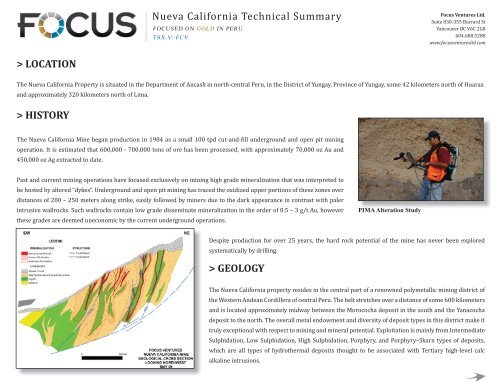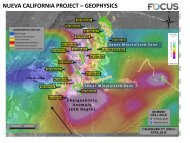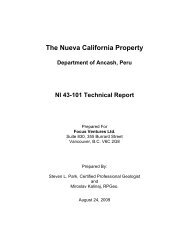Nueva California Technical Summary.indd - Focus Ventures Ltd.
Nueva California Technical Summary.indd - Focus Ventures Ltd.
Nueva California Technical Summary.indd - Focus Ventures Ltd.
Create successful ePaper yourself
Turn your PDF publications into a flip-book with our unique Google optimized e-Paper software.
<strong>Nueva</strong> <strong>California</strong> <strong>Technical</strong> <strong>Summary</strong><br />
FOCUSED ON GOLD IN PERU<br />
TSX.V: FCV<br />
<strong>Focus</strong> <strong>Ventures</strong> <strong>Ltd</strong>.<br />
Suite 830-355 Burrard St<br />
Vancouver BC V6C 2G8<br />
604.688.5288<br />
www.focusventuresltd.com<br />
> LOCATION<br />
The <strong>Nueva</strong> <strong>California</strong> Property is situated in the Department of Ancash in north-central Peru, in the District of Yungay, Province of Yungay, some 42 kilometers north of Huaraz<br />
and approximately 320 kilometers north of Lima.<br />
> HISTORY<br />
The <strong>Nueva</strong> <strong>California</strong> Mine began production in 1984 as a small 100 tpd cut-and-fill underground and open pit mining<br />
operation. It is estimated that 600,000 - 700,000 tons of ore has been processed, with approximately 70,000 oz Au and<br />
450,000 oz Ag extracted to date.<br />
Past and current mining operations have focused exclusively on mining high grade mineralization that was interpreted to<br />
be hosted by altered “dykes”. Underground and open pit mining has traced the oxidized upper portions of these zones over<br />
distances of 200 – 250 meters along strike, easily followed by miners due to the dark appearance in contrast with paler<br />
intrusive wallrocks. Such wallrocks contain low grade disseminate mineralization in the order of 0.5 – 3 g/t Au, however<br />
these grades are deemed uneconomic by the current underground operations.<br />
PIMA Alteration Study<br />
Despite production for over 25 years, the hard rock potential of the mine has never been explored<br />
systematically by drilling.<br />
> GEOLOGY<br />
The <strong>Nueva</strong> <strong>California</strong> property resides in the central part of a renowned polymetallic mining district of<br />
the Western Andean Cordillera of central Peru. The belt stretches over a distance of some 600 kilometers<br />
and is located approximately midway between the Morococha deposit in the south and the Yanacocha<br />
deposit to the north. The overall metal endowment and diversity of deposit types in this district make it<br />
truly exceptional with respect to mining and mineral potential. Exploitation is mainly from Intermediate<br />
Sulphidation, Low Sulphidation, High Sulphidation, Porphyry, and Porphyry–Skarn types of deposits,<br />
which are all types of hydrothermal deposits thought to be associated with Tertiary high-level calc<br />
alkaline intrusions.
The <strong>Nueva</strong> <strong>California</strong> deposit occurs in granodiorite of the Cordillera Blanca Batholith at its western edge,<br />
where it contacts with rocks of the Early Cretaceous (113 – 144 ma) Goyllarisquisca Group. The contact<br />
between the intrusive and sedimentary rocks is a northwest trending regional “range-front” fault that can<br />
be traced NNW– SSE along the entire western edge of the Batholith. The fault dips moderately to steeply<br />
southwest, and has normal and right lateral strike slip movement.<br />
The existing mine model interprets the high grade mineralization as hosted within a series of at least<br />
5 parallel NNW – SSE trending andesite dykes, which were originally part of the same structure having<br />
dislocated by a series of low angle faults and repeated down slope in a “staircase” arrangement. <strong>Focus</strong>’<br />
geologists believe that the mineralized dykes are in fact remnant layers or xenoliths of bituminous shale/<br />
siltstone and coal beds of the Cretaceous Chimu Formation that have been intruded and assimilated by the<br />
granodiorite sills and dykes. The sediments acted as the focus for intense hydrothermal activity evidenced<br />
by multiple pulses of quartz veining, quartz vein stockworks and siliceous hydrothermal breccias.<br />
The new interpretation is important for the future exploration potential of the deposit, interpreting the<br />
deposit as a large disseminated gold deposit with bulk mining potential. This new model depicts multiple mineralized zones within wider zones of low grade mineralization that<br />
extend to depth. Strike and width of the mineralization are presently unconstrained.<br />
The mineralization in the mine is for the most part strongly oxidized, consisting of goethite, limonite and lesser hematite as staining and as<br />
replacement of pyrite which is ubiquitous to the altered granodiorite and the sediments as fine and medium grained disseminations and<br />
veins, mostly with quartz. Oxidation penetrates at least to the lowest levels of the mine or 50 – 70 meters below surface. Other principal<br />
sulphide minerals are arsenopyrite, galena and sphalerite. Traces of chalcopyrite, pyrrhotite, covellite, bornite, and chalcocite have also<br />
been observed.<br />
> DEPOSIT CLASSIFICATION<br />
The <strong>Nueva</strong> <strong>California</strong> deposit is unusual in that it shows characteristics of both low and intermediate<br />
sulphidation categories, hosted by intensely altered high-level granodiorite intrusive and sedimentary<br />
rocks, however it is possible that it belongs to a “hybrid” class of Au-Ag deposits or is of higher<br />
temperature origin. Although the deposit is located in a region with world-class mineral endowment,<br />
the geology and mineralization is poorly understood. The geological setting, distribution, multiple<br />
mineralization styles and episodic nature of the alteration and the overall strength and magnitude of the hydrothermal system<br />
observed at <strong>Nueva</strong> <strong>California</strong> are characteristic of large gold systems, such as the nearby Pierina Mine.




